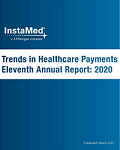 By Deirdre Ruttle, Chief Marketing Officer, InstaMed
By Deirdre Ruttle, Chief Marketing Officer, InstaMed
Twitter: @InstaMed
Twitter: @deirdre_ruttle
With 2021 in full swing, healthcare providers must continue to manage workflow efficiency, budgeting and the ongoing financial instability brought on by the COVID-19 pandemic. At the same time, patient payment responsibility remains high. Consequently, two-thirds of patients express concern about their ability to pay their healthcare expenses. Meanwhile, 63% of providers say that it takes more than a month to collect a patient balance in general.
The COVID-19 pandemic challenges the healthcare industry to rethink operations to minimize physical contact. This presents an opportunity for providers and hospitals to explore ways to use technologies that can enable contactless interactions and optimize their revenue cycles.
Here are four ways to improve your healthcare revenue cycle with digital solutions to help streamline workflows, increase patient engagement and ultimately improve cash flow.
Use Pre-Registration to Help Reduce Claim Denials
For healthcare providers looking to boost revenue cycle performance claim denials can pose a big problem. According to a recent Dimensional Insight and HIMSS Analytics survey, 76% of hospital heads cite claim denials as the leading revenue cycle management challenge, highlighting incorrect or missing information.
Patients can pre-register online or via their mobile device to help reduce claim denials. Patient pre-registration is an important step that involves collecting critical information before a medical procedure or visit. By obtaining this information in advance, providers can better ensure that the data received is accurate and verified before a visit even begins. This step not only cuts down on administrative tasks associated with patient check-in, it can ultimately improve collections. Obtaining payment information upfront and using online methods, can streamline collection efforts, remove paper from the registration process and make for a more convenient patient experience.
When patients have transparent information about their eligibility it helps to curtail confusion about what they will owe. It also reduces the chance that patients will be surprised by an unexpected expense that they are unprepared to pay. Using eStatements to deliver these details and enabling patients to pay through digital channels helps speed up the collection of outstanding balances.
Verify Benefits and Eligibility During Patient Visits
Patient benefits and eligibility verification are critical steps in the billing process. While this process is often time-consuming, it helps determine patients’ payment responsibility and can help ensure that providers get paid. You can expedite the verification process with technology that enables benefits and eligibility confirmation before and during patient visits, prior to claim submission. To gain the highest efficiencies, choose a revenue cycle management solution that connects to all of your available payers and delivers information on elements like effective coverage dates, covered procedures, co-pays and deductibles for a more comprehensive view into patients’ benefits.
Streamline Payment Posting With Automatic Collection
Forty-nine percent of providers cannot collect balances of more than $400 in 30 days. These payment delays slow down revenue cycles. Automating collections saves time and money associated with paper billing and other manual processes. Real-time payment posting can streamline the reconciliation process, reduce the risk and impact of bad debt, improve the patient experience and decrease the overall costs of collection. Look for a solution that allows automatic collection of patient balances using the payment method saved to the account during pre-registration. For added flexibility and to help patients better manage large balances, seek a solution that can set up automated payment plans.
Manage Revenue Cycle Performance With Reporting
Finally, optimize the performance of your revenue cycle with robust analytics. As many management experts know, you can’t manage what you don’t measure. Reporting that highlights the specific payment channels your patients use can help you recognize collection improvement opportunities. Implement a solution that shows performance metrics and trends across locations to help drive resource allocation and other critical business decisions.
This article was originally published on InstaMed and is republished here with permission.
 Trends in Healthcare Payments Eleventh Annual Report: 2020
Trends in Healthcare Payments Eleventh Annual Report: 2020
2020, a Year Like No Other
The COVID-19 pandemic impacted the United States and the entire world in significant, historic ways that will have lasting effects for decades to come. The healthcare industry was at the center of the pandemic, and the courage, grace and intelligence of frontline healthcare workers and all those who supported them should never be forgotten.
Last year’s edition of this report was released within weeks of the nationwide stay-at-home orders and social distancing measures implemented with the intention of slowing the spread of the COVID-19 outbreak. In the twelve months since then, our world has become saturated in new ways to be together without physical contact. The trends featured in this report show that the pandemic and subsequent lockdowns have likely changed the ways we interact forever. The healthcare industry was not immune to the impacts of the COVID-19 pandemic. From increased telehealth use to revenue hits, each stakeholder felt the pandemic’s touch this year. Download now.
